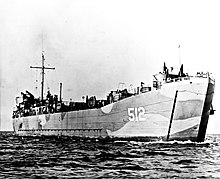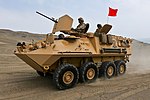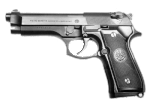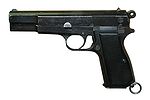| Peruvian Naval Infantry | |
|---|---|
| Infantería de Marina del Perú | |
 Coat of Arms of the Peruvian Naval Infantry Coat of Arms of the Peruvian Naval Infantry | |
| Founded | November 6, 1821; 203 years ago (1821-11-06) |
| Countries | |
| Type | Naval infantry |
| Role | Amphibious reconnaissance Amphibious warfare Anti-tank warfare Bomb disposal CBRN defense Close-quarters battle Combined arms Coastal defence Counter-battery fire Counterinsurgency Fire support Force protection HUMINT Indirect fire Intelligence assessment Internal security Irregular warfare Jungle warfare Maneuver warfare Military engineering Mountain warfare Naval boarding Reconnaissance Urban warfare |
| Size | 4,000 |
| Part of | |
| Motto(s) | Acción y valor (English: Action and valor) |
The Peruvian Naval Infantry (IMAP) (Spanish: Infantería de Marina del Perú) is the only naval infantry brigade unit branch of the Peruvian Navy (MGP). Consisting of 4,000 personnel, the branch, which falls under the Pacific Operations General Command, includes an amphibious warfare brigade made up of three battalions, internal security units, jungle warfare unit made up of two battalions, two troopships, four landing craft and forty armoured personnel carriers. Since 1982, IMAP detachments have been deployed in anti-irregular military, counterinsurgency, and jungle warfare operations in the Ayacucho and Huancavelica departments of Peru.
History
Founding
Following the creation of the Peruvian Navy on 23 October 1821, the Commander General of the Navy, Jorge Martín Guise, requested a garrison of 38 troops to be stationed at Balcarce and Belgrano. The formal request was made on 6 November 1821 to the Minister of War and Navy, creating the Navy Battalion. The Navy Brigade was later formed after another battalion was formed and on 2 June 1823, the brigade attacked the Spanish in Arica, successfully taking the city. During the War of the Confederation, the Navy Brigade fought in the Siege of Talcahuano on 23 November 1837. In 1847, President Ramón Castilla reorganized the Peruvian Navy, creating six companies of the naval infantry.
War of the Pacific
During the War of the Pacific, the Marines Garrison Battalion under the direction of the Commander General of the Navy was created on 10 January 1880 with a force of 600 men. The Marines participated in the Battle of Miraflores on 15 January 1881 with 524 marines led by Juan Fanning and Guardia Chalaca. Both of the commanders were killed along with nearly all Marines, with the infamous shout of Fanning becoming a motto of the Peruvian Marines, "¡Adelante marina, marina adelante!" or "Forward Marine, Marine forward!".
Modernization

The Marines were received an update on 2 February 1919 when the Battalion of the Navy was organized into two companies of riflemen, one section of machine gunners and another section of servicemen, commanded by corvette captain Héctor Mercado. The Peruvian Navy in charge of defending the oil port of Talara then allied itself with the United States, patrolling the continent and the Panama Canal. On 9 June 1943, President Manuel Prado decreed the creation of the Infantería de Marina as part of the Naval Coast Defense Force. Through the 1950s and into the 1960s, multiple amphibious warfare ships and weapons were purchased. The Naval Station of Ancon was created on October 8, 1971, with the Amphibious Command Company headquartered there a year later providing logistical information to better organize amphibious operations.
Counterterrorism
Further information: Terrorism in Peru
Following over a decade of an authoritarian government in Peru, elections were held in 1980. Leftist armed groups arose, such as the Shining Path and later the Túpac Amaru Revolutionary Movement (MRTA). The Marines began anti-irregular military, counterinsurgency, and counterterrorist operations against such groups stationed in the Ayacucho Region from 1985 to 1991, creating Task Force 90, later expanding to Ucayali, Huánuco and Loreto. In 1995, Marines also participated in the brief the Cenepa War, a brief territorial conflict with Ecuador.
On 17 December 1996, hundreds of diplomats, businessmen, as well as government and military officers were taken hostage by the MRTA at the Japanese ambassadors residence, initiating the Japanese embassy hostage crisis. Over the year, some hostages were released, though 72 hostages remained. Peruvian Marines were then involved in a hostage rescue operation, Operation Chavín de Huántar, named after the Chavín de Huantar archaeological site due to the tunnels dug by troops to access the ambassadors compound. The operation resulted in two commandos and one hostage dead while all fourteen militants were killed.
Organization

Brigada de Infanteria de Marina
- 1st Naval Infantry Battalion - Ancón
- 2nd Naval Infantry Battalion - Ancón
- Amphibious Support Group
- Commando Grouping
- Engineers Unit
- Fire support Group
Other units
- 3rd Naval Infantry Battalion - Tumbes
- 4th Naval Infantry Battalion - Puno
- 1st Jungle Naval Infantry Battalion - Iquitos
- 2nd Jungle Naval Infantry Battalion - Pucallpa
- Naval Infantry Detachment Litoral Sur - Mollendo
- Special Forces Espíritus Negros and Fuerza Delta, based on the American Delta Force and US Army Rangers.
Equipment
Weapons
Vehicles
| Name | Image | Type | Quantity | Origin | Details |
|---|---|---|---|---|---|
| Armoured vehicles | |||||
| LAV‑II |  |
APC | 32 | All 32 delivered to the Amphibious Expeditionary Brigade (BEA) of the Marines in mid-2016. | |
| BMR-600 |  |
APC | 8 | 4 Units donated to the National Police of Peru. The rest are kept as transport for the troops of the United Nations peacekeeping missions. It is projected to go into retirement together and be replaced by a new batch of LAV II | |
| Bravia Chaimite |  |
APC | 9 | It is projected to go into retirement together and be replaced by a new batch of LAV II | |
| Utility vehicles | |||||
| Can-Am Commander Max |  |
Off-road vehicle | |||
| RAM MK3 |  |
Armoured light vehicle | 7 | Purchased in 2016 | |
See also
References
- ^ International Institute for Strategic Studies (IISS) (2021). "The Military Balance 2021". The Military Balance.
- ^ "Comandancia de Fuerzas de Infanteria - Marina de Guerra del Perú". www.marina.mil.pe. Marina de Guerra del Perú. Archived from the original on 29 December 2016. Retrieved 29 December 2016.
- ^ Montes, Julio A. (August 2011). "Peruvian Small Arms: Gunning for the Shining Path" (PDF). Small Arms Defense Journal: 25–29.
- ^ "www.portierramaryaire.com • Ver Tema - Marina de Guerra del Perú". www.portierramaryaire.com (in Spanish). Retrieved 4 June 2017.
- "PLAYAS DE HUACHO FUERON ESCENARIO DE GRAN DESEMBARCO ANFIBIO EN EL MARCO DE OPERACIÓN UNITAS 2017".
- ^ ":.DintelGID. Fotografías Desfile Militar día Nacional del Perú, 2007". 25 May 2009. Archived from the original on 25 May 2009. Retrieved 5 January 2017.
- "轻武器大杂烩:秘鲁军队阅兵式枪的种类可真不少!_陆军版_三军论坛_军事论坛_新浪网". club.mil.news.sina.com.cn. Retrieved 5 January 2017.
- "Reclamo a la adquisición de Armamento para las Fuerzas Especiales de la Marina de Guerra del Perú-noticia defensa.com". Defensa.com. 14 February 2017. Retrieved 3 June 2017.
- "GDLS culmina las entregas de LAV II a la Infantería de Marina peruana-noticia defensa.com". Defensa.com. 19 August 2016. Retrieved 23 July 2017.
- "La Marina de Perú adquiere siete blindados RAM MK3 de IAI - Noticias Infodefensa América". Infodefensa.com (in Spanish). 21 January 2016. Retrieved 3 January 2017.
External links
- Official Peruvian Navy Website
- The Peruvian Navy: the XIX Century Maritime Campaigns — a series of articles covering the history of the 19th century Peruvian Navy by Juan del Campo.
- Marine Link article with pics
| Service Branches |  | |
|---|---|---|
| Wars and Conflicts | ||
| Related dependencies | SIMA | |















